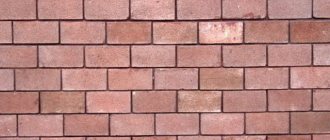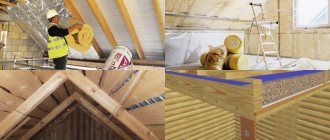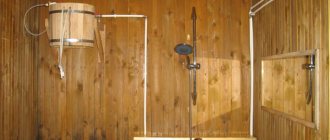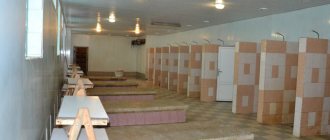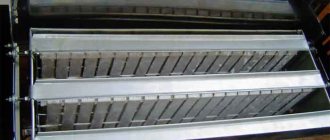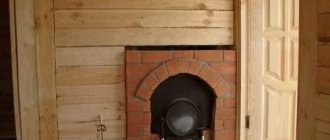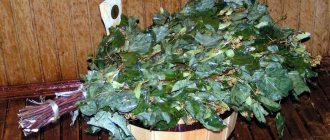To make the room reliable and durable, it is necessary to equip a solid foundation. To accomplish this task, a blind area made of concrete is used, since this material is considered one of the most reliable. Compliance with installation rules will allow you to create a high-quality structure that will be used for its intended purpose for many years.
What is
A concrete blind area is an external structure with waterproofing, which is installed along the perimeter of the building and has a slight slope from the wall to the topography of the garden area. According to the requirements of the project, the structure is pressed tightly against the base of the house, but is made movable. In structure, it resembles a layer cake, which has the following components:
- Base layer (bedding). It is created from crushed stone or clay.
- Waterproofing layer.
- The top covering is concrete.
Protective measures after concrete placement
After compaction, it is necessary to provide the concrete with conditions to gain strength. After pouring, to maintain optimal humidity and temperature, it is recommended:
- Moistening the concrete every 8 hours – for 3–7 days;
- Covering with plywood panels or slate sheets leaning against the wall above the blind area at an angle.
If there is no possibility of constant moistening, you can simply cover it with a polymer film with a thickness of at least 200 microns. The joints of the film should be sealed using tape or PVC adhesive tape.
If concrete is not properly maintained, the risk of cracks and deformations increases, and the final strength decreases.
The formwork (if there are no defects in it) can be removed when the concrete gains 70% strength - after 14 days.
Grinding concrete with a grinder
Functions performed
Organizing a blind area around a concrete house with your own hands is an important stage of construction, which performs a number of useful functions and affects the durability of a residential building. The main purpose of such a structure is to effectively drain water from wall structures and the foundation of the house.
A high-quality concrete blind area extends the service life of a building by preventing deformation of the base during prolonged exposure to precipitation, groundwater and other factors. Having a temporary concrete structure will effectively drain and transport water away from the foundation.
If it is missing, and a lawn or flower bed is tightly adjacent to the room, this will negatively affect the waterproofing and increase the risk of destruction of the base by the root system from garden plantings that grow nearby.
Constant rain and snow will also become a big problem, since moisture accumulated in the soil will begin to affect the foundation, contributing to its rapid destruction.
For many years, the technology for constructing a blind area consisted of using clay, which was placed in a special trench around the perimeter of the building and carefully compacted. The finished layer is additionally moistened to form a waterproof film.
Today, concrete blind areas are the most common, the manufacturing technology of which has its own nuances. This material has many advantages, since it allows you to create a smooth surface without gaps, cracks or cracks, which enhances the insulation of the base of the house.
At the same time, experts recommend filling the blind area with concrete even if there is no finance for organizing the finishing touches. And for the design to be as efficient as possible, it is better to equip it before the cold weather.
The list of the main functions of the structure looks like this:
- Presentable appearance of the exterior. The presence of a competently constructed blind area is the final stage in the design of the outer part of the room.
- Protection and drainage. The design saves a garage or private house from the negative effects of groundwater and rainwater. And if it is equipped with a storm drain, all excess liquid ends up in the sewer pit.
- Soil stabilization. The thickness of the concrete blind area allows the soil layers to breathe normally and at the same time prevents the penetration of large living organisms along the base.
- Reinforced thermal insulation. With the help of such a protective covering, the degree of soil freezing is reduced, so there is always a comfortable microclimate in the house.
- Protection against soil swelling.
Tips for choosing materials
To create a blind area from crushed stone with your own hands you will need:
- Oily clay.
There are three types of clay depending on the sand content: lean, medium and fat. You need fatty clay, because it contains the least amount of sand.
- Rolled waterproofing: roofing felt, polyethylene or PVC film.
Rolled waterproofing is the most convenient to use: the material is simply rolled out. The joints are overlapped and coated with bitumen mastic.
- Coarse sand.
River sand without impurities is used, with a particle size from 3mm to 5mm. The use of fine sand is not allowed.
- Geotextiles.
This is a rolled non-woven material that allows water to pass through freely and serves to separate the layers of the blind area. When choosing geotextiles, you should pay attention to the density of the material; it is advisable to use a material with a density in the range of 100-150g/m2.
- Crushed stone.
To make a blind area around a multi-story building or a house with heavy walls, it is better to choose more durable crushed granite. Crushed stone made of dolomite and limestone is resistant to temperature changes. By size, crushed stone is divided into fractions, which determine the size of the element.
Fine stones from 5mm to 20mm are easily compacted. And the middle fraction, ranging in size from 20 to 40 mm, has a more attractive appearance and a lower price. The best option is to choose a mixture of fine and medium fractions.
Requirements for the blind area and design rules
When starting the process of constructing a concrete blind area with your own hands, you need to make sure that it has the same width, 20-30 cm greater than the overhang of the cornice. In most cases, architects adhere to dimensions of about 1 m (this value can be deviated when placing strip foundations on subsiding soil). The encircling structure is buried to half the freezing point of the soil. Its thickness varies from 7-10 cm. If it acts as a path, a deviation of up to 15 cm is allowed.
The optimal slope of the blind area is 92-94 degrees from the load-bearing wall. The base can rise by 50 cm. The outer lower side is raised 50 mm above ground level to ensure effective drainage.
How to make a blind area
If you are interested in how to properly make a blind area around a house with your own hands from concrete, you should read the step-by-step instructions and mark the ground. You should also prepare the area by getting rid of the fertile layer of soil and laying out a sandy or clay layer.
Next, a geotextile covering is laid on the ground (in most cases, roofing felt is used as it), and formwork is also installed. The perimeter is additionally reinforced, and the concrete mixture, created in the appropriate proportion, is placed in the formwork.
Preparation of tools and materials
When starting the construction of a concrete blind area around a house with insulation, it is important to take care of all the necessary tools and materials. Excavation work is carried out using a shovel, pickaxe, twine, compactor, pegs and construction tape.
You also need to prepare the optimal amount of waterproof film for the water seal. Next you should find all the additives for mixing the concrete mixture, which include:
- Moistened sand.
- Water.
- Gravel.
- Crushed stone.
- Cement.
As an alternative, you can use a ready-made mixture labeled M400 and higher. Necessary tools include a mixer for diluting the mixture, shovels, stretchers, a measuring bucket and other containers. The underlying layer consists of clay or sand.
To arrange the tape formwork, boards are used, so the construction site must have a hacksaw, a building level, and a hammer with nails. For reinforcement, steel mesh, welding equipment and tools for cutting metal elements are used.
Marking
Before digging a trench along its perimeter, it is necessary to secure the pegs and stretch a string between them. The location where the blind area adjoins the plinth is indicated using special beacons with a permissible step of up to 1.5 m.
The top layer of fertile soil is removed taking into account the landscape design. Sand or clay is placed at the bottom of the recess and then compacted thoroughly. The maximum depth can reach 500 mm for heaving soil.
Creation and compaction of a sand cushion
The bottom layer of the recess is equipped with a drainage system, on top of which 10-20 cm of sand is poured. The exact thickness of this embankment is determined by the type of blind area and the depth of its placement. The sand is carefully leveled and compacted.
To reduce the time and effort required when performing such actions, you can fill the trench with water and wait until it soaks into the soil. In this case, the sand will be better compacted.
If groundwater lies close enough to the surface, installing a drainage system will be an obligatory step. It uses a tube with special holes, which is laid around the entire perimeter and connected to the general sewer system of a private house through a storm drain.
Waterproofing
To create effective waterproofing, you can use the following materials:
- Bitumen mastic or tar.
- Ruberoid and other rolled waterproofing materials.
- Available solutions in the form of geotextiles, rubemast, polypropylene and a number of other materials.
- Hydrocements and asphalt concretes.
- Mastered.
- All kinds of polymer products for placing a waterproofing layer between the blind area and the foundation.
When starting to waterproof the blind area around a concrete house, it is important to completely get rid of the fertile layer of soil around the entire perimeter at a distance of up to 1.5 m before construction. If there are no financial restrictions, all compacted clay must be covered with a roll of waterproofing material. To improve protection against moisture penetration, several layers of hot bitumen can be made. Next, backfilling with crushed stone and compaction is carried out.
Creating formwork
To extend the life of the enclosing blind area, it is important to provide high-quality formwork. It is made from boards 30 mm thick. The height is determined taking into account the dimensions of the blind area. Experts recommend applying markings to the boards to monitor the thickness of each layer.
Having secured the base, all that remains is to strengthen the structure with twine and corners. They are placed from the outside, and bolts are used to tighten them. If an individual section is damaged, it is enough to unscrew the bolt to carry out repair work.
The diameter of the fastening elements is 1 cm. If you do not have to restore the formwork, all wooden elements will need to be treated with an antiseptic. And to extend their service life, it is recommended to make an insulating layer based on roofing felt. Such a solution not only provides reliable protection of the formwork from rot and mold, but also increases the durability of the blind area.
Large formwork is reinforced with supports or blocks. Even at the stage of its installation, an expansion joint is created, it is placed near the junction of the blind area and the wall structure and is installed across the structure. The presence of an expansion joint will prevent possible consequences from temperature surges. If you do not do this, the blind area will become covered with cracks.
For error-free installation of transverse joints on the formwork, a distance of 2 m should be maintained. Wooden formwork is effective only for concrete enclosing structures. If the blind area is created on the basis of other materials without filling, a wooden base is not necessary.
Reinforcement and filling
To strengthen the structure, a metal mesh with dimensions of 50x50 (100x100 mm) and pieces of reinforcement are taken, fixed in the base in increments of 0.75 m. The mesh is raised above the crushed stone by 30 mm, and the concrete base is mixed and poured independently.
At the reinforcement stage, it is necessary to prevent the appearance of air pockets in the concrete. To do this, you should adhere to the proportions that are used in the production of concrete for laying roads. Cement grade M400 and higher is used as the finished mixture.
The composition may also contain various additives that give it increased strength and reliability.
Leveling and drying
To level the upper surface of the blind area, you must adhere to a number of rules and requirements. It is recommended to carry out the procedure of covering the screed with dry cement 1-2 hours after ironing. The top layer should have a thickness of 3 to 7 mm. After this, the coating is thoroughly rubbed, and an opaque polyethylene film is laid on top. The blind area can be called ready in 1.5-2 weeks.
Excavation
The first stage is marking the trench using pegs and twine. The following is the algorithm:
Removal of fertile soil is strictly manual. If the fertile layer is thin, the thickness of soil required to accommodate all layers of the “pie” (25–50 cm) is removed. The inside of the trench can be treated with a herbicide - this will protect the sand and gravel bed from plant roots.
There should be no large stones, roots, or sharp objects left at the bottom of the trench. The excavated soil can be removed, distributed throughout the territory - there will be no need for it.
Compacting and leveling the bottom of the trench - already at this stage a slope should be formed.
Laying geotextile on the bottom - the “fabric” must be distributed over the entire surface, overlapping the foundation and the opposite wall of the trench.
If a foundation pit was dug (and then filled in) for a house, then the blind area should extend beyond it by at least 40 cm. In addition, the bottom of the trench will need to be compacted more thoroughly.
If the waterproofing of the base is damaged during backfilling a pit or digging a trench, it needs to be renewed at this stage.
How to protect the blind area from destruction
Since concrete is used to construct a boundary strip around the perimeter of the foundation, it may be subject to damage and cracks. Most defects are a series of deep or superficial cracks, traces of crumbling and subsidence. Cases of tiles peeling off from the basement of the building cannot be ruled out.
Such phenomena are associated with the following factors:
- Failure to comply with installation rules. Often, builders ignore the importance of waterproofing, do not ensure optimal compaction and uniformity of backfill, do not comply with dimensional standards and make other primitive mistakes. Another problem arises when choosing the wrong recipe for a concrete mixture, when the composition contains an insufficient or excessive amount of binder additive. The first option threatens cracking of the surface, and the second - crumbling.
- The absence of an expansion joint that prevents damage to the supporting structure due to temperature changes or precipitation.
- Lack of reinforcement in the blind area. Some home craftsmen refuse to lay this layer, arguing that its presence is not specified in SNiP standards. However, the metal elements make the strip not only functional, but also durable.
To protect the blind area from any negative factors, it is important to monitor the width and density of filling expansion joints and restore them in time. Instead of wood, it is better to use 15 mm thick vinyl tapes. If the building stands on heaving soil, the blind area should not be connected to the basement part.
To increase the tightness of the concrete composition, it is treated with a deep penetration primer.
Reinforcement
Reinforcement of concrete is not specified in the standards, but metal reinforcement:
- will increase compressive and tensile strength - will reduce the risk of concrete cracking due to subsidence, soil displacement or changes in the weight of the building (when constructing superstructures or replacing the roof);
- will give additional rigidity;
- will make it easier to repair the concrete strip in the future.
For reinforcement, it is better to buy a ready-made mesh of size 50*50*5, 100*100*4 and 150*150*8 - the larger the diameter of the rod, the larger the cell size.
You can make the frame yourself by cutting and laying perpendicularly a metal rod with a thickness of 4 to 16 mm, with cells from 100 to 200 mm. The rod is fastened with binding wire.
It is optimal for the mesh to be raised above the surface by 1–2 cm - this is achieved by installing special inserts.
Laying rules:
- The mesh is laid in 1 layer - overlaps are made only at the joints.
- They start with straight sections - the corners are reinforced last with the help of specially cut “corner” mesh fragments.
- Do not use rods or mesh of different thicknesses.
Proportions of concrete in buckets (for foundations, outdoor screeds, fence posts)
The reinforcing mesh should not be attached to the foundation - during shrinkage, this will only accelerate the formation of cracks.
Repair of concrete blind area
If traces of cracking, peeling or other deformation processes appear on the blind area, it is necessary to quickly begin repairs and get rid of the resulting defects. If they are strong and deep enough, you will need to completely replace the coating.
To eliminate small gaps from temperature effects, it is enough to use sealants and fillers. The wide hole is filled with sand and cement with fine crushed stone to ensure optimal insulation.
The dry coating is treated with a primer. The same actions are performed with cracks in the surface of sections.
The presence of a concrete strip around the perimeter of the house is a guarantee of the reliability and durability of the foundation of the house. But in order for the structure to be as durable and functional as possible, it is important to follow the rules of its construction and follow the instructions exactly. It is also important to correctly calculate the thickness of the concrete blind area, apply all the required markings and be careful at each stage of construction.
Why is a profiled membrane more profitable?
In the case of PLANTER Geo, one of the most expensive items - concrete - disappears from the list of required materials. If we take average prices for building materials, savings can be up to 45%. Considering the considerable cost of the blind area in general, this is a very good indicator. For those who plan to build a house on their own, including the blind area, there is a nice bonus - the work will be much easier, simpler and faster. You don’t need any equipment or special tools, which is also very significant for savings. An exception is tools for laying the finishing coating if, for example, you decide to lay paving slabs. The finishing layer is laid on the PLANTER Geo membrane

